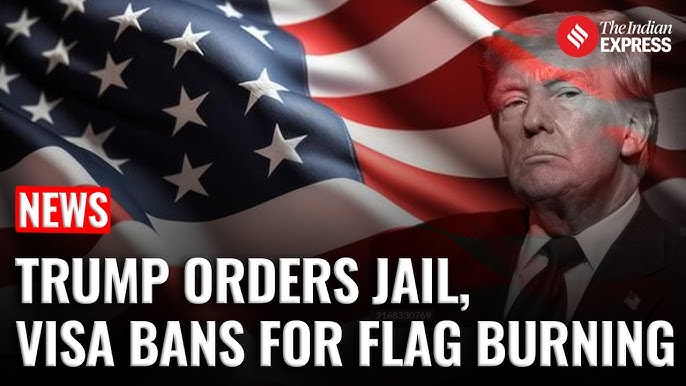A Clash Between Freedom of Expression and Flag Desecration
A landmark judgement in 1989 by the Supreme Court of the United States delineated that the act of desecrating the American flag is a manifestation of speech, and hence safeguarded by the First Amendment rights. This constitutionally protected right was challenged in August of 2025 when U.S. president, Donald Trump, sanctioned an executive order, ‘Prosecuting Burning of the American Flag.’, which was designed to legally pursue those involved in an act of burning the American flag. This initiative was extended even to non-Americans by implying potential termination or revocation of their visas. The contrast between this executive order and the 1989 Supreme Court ruling was evident.
Interestingly, the 2025 executive order did not stipulate any specific punitive measures for the act of flag desecration. The speculation regarding Trump’s intentions of having flag burners face a year-long imprisonment seems to have been stimulated by his statement during the signing of the executive order. The First Amendment’s protection of the right to burn an American flag was brought to light by the Supreme Court case, ‘Texas v. Johnson’ in 1989.
‘Prosecuting Burning of the American Flag,’ became significant on the 25th of August, 2025, when Trump ratified it officially. As he signed the executive order, he remarked, ‘If you burn a flag, you get one year in jail, no early exits, no nothing.’ However, our investigations reveal that while the executive order indeed aimed to penalize flag burners, it did not elucidate the specific punitive measure for the act.
The controversy surrounding the legality of Trump’s executive order serves as an entirely distinct topic of discussion. The landmark judgement in the 1989 ‘Texas v. Johnson’ case offered a precedent that contrasted the perspectives of the mentioned executive order. In the turbulent period during the Vietnam War in 1968, marked by extensive protests, the American Congress went ahead to enact the ‘Flag Protection Act,’ which essentially outlawed flag desecration.
The story of Gregory Lee Johnson, who burned the American flag at the Dallas City Hall in 1984 as a demonstration against Ronald Reagan’s policies, adds another dimension to this discussion. Following this act, Johnson was detained on account of a Texas law that outlawed the desecration of any revered object, and served a punishment of a year in jail, along with a fine of $2,000. Despite the initial punishment, Johnson challenged the judgement, which resulted in the appeal reaching the Supreme Court.
The Supreme Court, in a narrow 5-4 verdict, sided with Johnson, affirming that the First Amendment protected the act of burning the flag. This groundbreaking judgement instantaneously overturned preceding state and federal laws that considered flag desecration illegal. Since this verdict, the Congress has made unfruitful attempts to enforce a constitutional amendment that deems flag desecration as illegal.
Trump has been reported to discuss the prospect of outlawing flag desecration intermittently since November of 2016. Justifying such an executive order aligned with the aforementioned goal could prove challenging, despite the fact that the Supreme Court’s composition has become significantly more conservative since the 80s.
Trump’s executive order implied that flag desecration ‘may incite violence and riot,’ – a view that stood in direct opposition with the Supreme Court’s decision in ‘Texas v. Johnson.’ Nevertheless, the executive order pressed for the U.S Attorney General to ‘vigorously prosecute those who violate our laws in ways that involve desecrating the American Flag’ leading to ‘harm unrelated to expression.’
The order further postulated that these transgressions might encompass ‘violent crimes; hate crimes; and crimes against property and the peace, as well as conspiracies and attempts to violate, and aiding and abetting others to violate, such laws.’ However, the executive order refrains from further outlining ‘other violations of Americans’ civil rights.’
The executive order proposed additional powers to the secretary of state, attorney general, and the secretary of homeland security. This encompassed the authority to ‘deny, prohibit, terminate, or revoke visas, residence permits, naturalization proceedings, and other immigration benefits, or seek removal from the United States,’ – applicable especially to noncitizens involved in the act of flag burning.
Thus, the executive order marked a significant divergence from established law, demonstrating the ongoing development and contentious nature of free speech rights in America. Future considerations of this directive would invariably involve weighing up principles of free expression, respect for national symbols, and the potential for provocative actions to incite unrest. While the debate continues, the historical and legal precedents of such issues set a framework for discussions moving forward.


